The Effect of Heating on Properties of Sandy Soils
Abstract
:1. Introduction
2. Material and Methods
2.1. Site Description
2.2. Soil Sampling and Heating Experiment
2.3. Measurement of Soil Properties
2.4. Statistical Analysis
3. Results
4. Discussion
5. Conclusions
Author Contributions
Funding
Data Availability Statement
Conflicts of Interest
References
- Li, T.L.; Jeřábek, J.; Winkler, J.; Vaverková, M.D.; Zumr, D. Effects of prescribed fire on topsoil properties: A small-scale straw burning experiment. J. Hydrol. Hydromech. 2022, 70, 450–461. [Google Scholar] [CrossRef]
- Lin, M.Y.; Begho, T. Crop residue burning in South Asia: A review of the scale, effect, and solutions with a focus on reducing reactive nitrogen losses. J. Environ. Manage. 2022, 314, 115104. [Google Scholar] [CrossRef]
- Rasoulzadeh, A.; Sepaskhah, A.R.; Asghari, A.; Ghavidel, A. Long-term effects of barley residue managements on soil hydrophysical properties in north-western Iran. Geoderma Reg. 2022, 30, e00552. [Google Scholar] [CrossRef]
- Armas-Herrera, C.M.; Martí, C.; Badía, D.; Ortiz-Perpiñá, O.; Girona-García, A.; Porta, J. Immediate effects of prescribed burning in the Central Pyrenees on the amount and stability of topsoil organic matter. Catena 2016, 147, 238–244. [Google Scholar] [CrossRef]
- Cerdà, A.; Lucas-Borja, M.E.; Franch-Pardo, I.; Úbeda, X.; Novara, A.; López-Vicente, M.; Popović, Z.; Pulido, M. The role of plant species on runoff and soil erosion in a Mediterranean shrubland. Sci. Total Environ. 2021, 799, 149218. [Google Scholar] [CrossRef]
- Bonanomi, G.; Idbella, M.; Abd-ElGawad, A.M.; Motti, R.; Ippolito, F.; Santorufo, L.; Adamo, P.; Agrelli, D.; De Marco, A.; Maisto, G.; et al. Impact of prescribed burning, mowing and abandonment on a Mediterranean grassland: A 5-year multi-kingdom comparison. Sci. Total Environ. 2022, 834, 155442. [Google Scholar] [CrossRef]
- Tulganyam, S.; Carr, C.A. Short-term vegetation response to bulldozed fire lines in Northern Great Plains grasslands. Fire 2022, 5, 79. [Google Scholar] [CrossRef]
- Brucker, C.P.; Livneh, B.; Minear, J.T.; Rosario-Ortiz, F.L. A review of simulation experiment techniques used to analyze wildfire effects on water quality and supply. Environ. Sci. Process. Impacts 2022, 24, 1110. [Google Scholar] [CrossRef]
- Novák, V.; Lichner, Ľ.; Zhang, B.; Kňava, K. The impact of heating on the hydraulic properties of soils sampled under different plant cover. Biologia 2009, 64, 483–486. [Google Scholar] [CrossRef]
- Stoof, C.R.; Wesseling, J.G.; Ritsema, C.J. Effects of fire and ash on soil water retention. Geoderma 2010, 159, 276–285. [Google Scholar] [CrossRef]
- Hološ, S.; Šurda, P.; Lichner, Ľ.; Zvala, A.; Píš, V. Fire-induced changes in soil properties depend on age and type of forests. J. Hydrol. Hydromech. 2022, 70, 442–449. [Google Scholar] [CrossRef]
- Martínez, S.I.; Contreras, C.P.; Acevedo, S.E.; Bonilla, C.A. Unveiling soil temperature reached during a wildfire event using ex-post chemical and hydraulic soil analysis. Sci. Total Environ. 2022, 822, 153654. [Google Scholar] [CrossRef]
- Csecserits, A.; Czucz, B.; Halassy, M.; Kröel-Dulay, G.; Rédei, T.; Szabó, R.; Szitár, K.; Török, K. Regeneration of sandy old-fields in the forest steppe region of Hungary. Plant Biosyst. 2011, 145, 715–729. [Google Scholar] [CrossRef]
- Hewelke, E. Influence of abandoning agricultural land use on hydrophysical properties of sandy soil. Water 2019, 11, 525. [Google Scholar] [CrossRef]
- Hewelke, E.; Gozdowski, D.; Korc, M.; Małuszynska, I.; Górska, E.B.; Sas, W.; Mielnik, L. Influence of soil moisture on hydrophobicity and water sorptivity of sandy soil no longer under agricultural use. Catena 2022, 208, 105780. [Google Scholar] [CrossRef]
- Lichner, L.; Felde, V.J.M.N.L.; Büdel, B.; Leue, M.; Gerke, H.H.; Ehlerbrock, R.H.; Kollár, J.; Rodný, M.; Šurda, P.; Fodor, N.; et al. Effect of vegetation and its succession on water repellency in sandy soils. Ecohydrology 2018, 11, UNSP e1991. [Google Scholar] [CrossRef]
- Toková, L.; Hološ, S.; Šurda, P.; Kollár, J.; Lichner, L. Impact of duration of land abandonment on hydrological processes in sandy soil. Agriculture 2022, 12, 68. [Google Scholar] [CrossRef]
- Leelamanie, D.A.L.; Nishiwaki, J. Water repellency in Japanese coniferous forest soils as affected by drying temperature and moisture. Biologia 2019, 74, 127–137. [Google Scholar] [CrossRef]
- Doerr, S.H.; Shakesby, R.A.; Walsh, R.P.D. Soil water repellency: Its causes, characteristics and hydrogeomorphological significance. Earth Sci. Rev. 2000, 51, 33–65. [Google Scholar] [CrossRef]
- Popovic, Z.; Cerdà, A. Soil water repellency and plant cover: A state-of-knowledge review. Catena 2022, 229, 107213. [Google Scholar] [CrossRef]
- Kottek, M.; Grieser, J.; Beck, C.; Rudolf, B.; Rubel, F. World map of the Köppen-Geiger climate classification updated. Meteorol. Z. 2006, 15, 259–263. [Google Scholar] [CrossRef]
- WRB. World Reference Base for Soil Resources 2014. Update 2015. World Soil Resources Reports No. 106; FAO: Rome, Italy, 2015; 192p. [Google Scholar]
- ISO 11277; Soil Quality. Determination of Particle Size Distribution in Mineral Soil Material. Method by Sieving and Sedimentation. International Organization of Standardization: Geneva, Switzerland, 2009. Available online: https://www.iso.org/standard/54151.html (accessed on 3 July 2023).
- ISO 10390; Soil Quality. Determination of pH. International Organization of Standardization: Geneva, Switzerland, 2005. Available online: https://www.iso.org/standard/40879.html (accessed on 3 July 2023).
- Doerr, S.H. On standardizing the “Water Drop Penetration Time” and the “Molarity of an Ethanol Droplet” techniques to classify soil hydrophobicity: A case study using medium textured soils. Earth Surf. Process. Landf. 1998, 23, 663–668. [Google Scholar] [CrossRef]
- Tinebra, I.; Alagna, V.; Iovino, M.; Bagarello, V. Comparing different application procedures of the water drop penetration time test to assess soil water repellency in a fire affected Sicilian area. Catena 2019, 177, 41–48. [Google Scholar] [CrossRef]
- Bisdom, E.B.A.; Dekker, L.W.; Schoute, J.F.T. Water repellency of sieve fractions from sandy soils and relationships with organic material and soil structure. Geoderma 1993, 56, 105–118. [Google Scholar] [CrossRef]
- Bachmann, J.; Horton, R.; van der Ploeg, R.R.; Woche, S. Modified sessile drop method for assessing initial soil-water contact angle of sandy soil. Soil Sci. Soc. Am. J. 2000, 64, 564–567. [Google Scholar] [CrossRef]
- Goebel, M.-O.; Woche, S.K.; Abraham, P.M.; Schaumann, G.E.; Bachmann, J. Water repellency enhances the deposition of negatively charged hydrophilic colloids in a water-saturated sand matrix. Colloids Surf. A Physicochem. Eng. Asp. 2013, 431, 150–160. [Google Scholar] [CrossRef]
- Papierowska, E.; Matysiak, W.; Szatyłowicz, J.; Debaene, G.; Urbanek, E.; Kalisz, B.; Łachacz, A. Compatibility of methods used for soil water repellency determination for organic and organo-mineral soils. Geoderma 2018, 314, 221–231. [Google Scholar] [CrossRef]
- NCSS 12 Statistical Software. Statistical Software; N.C.S.S., L.L.C.: Kaysville, UT, USA, 2018; Available online: https://www.ncss.com/software/ncss/ (accessed on 3 July 2023).
- Badía, D.; Martí, C. Effect of simulated fire on organic matter and selected microbiological properties of two contrasting soils. Arid Land Res. Manag. 2003, 17, 55–69. [Google Scholar] [CrossRef]
- Santín, C.; Doerr, S.H.; Preston, C.M. Pyrogenic organic matter production from wildfires: A missing sink in the global carbon cycle. Glob. Chang. Biol. 2015, 21, 1621–1633. [Google Scholar] [CrossRef]
- Schnitzer, M.; Hoffman, I. Pyrolysis of soil organic matter. Soil Sci. Soc. Am. J. 1964, 28, 520–525. [Google Scholar] [CrossRef]
- Úbeda, X.; Pereira, P.; Outeiro, L.; Martin, D.A. Effects of fire temperature on the physical and chemical characteristics of the ash from two plots of cork oak (Quercus suber). Land Degrad. Dev. 2009, 20, 589–608. [Google Scholar] [CrossRef]
- Negri, S.; Stanchi, S.; Celi, L.; Bonifacio, E. Simulating wildfires with lab-heating experiments: Drivers and mechanisms of water repellency in alpine soils. Geoderma 2021, 402, 115357. [Google Scholar] [CrossRef]
- Perera, H.T.M.; Leelamanie, D.A.L.; Maeda, M.; Mori, Y. Alterations in aggregate characteristics of thermally heated water-repellent soil aggregates under laboratory conditions. J. Hydrol. Hydromech. 2023, 71, 177–187. [Google Scholar] [CrossRef]
- Samburova, V.; Shillito, R.M.; Berli, M.; Khlystov, A.Y.; Moosmüller, H. Effect of biomass-burning emissions on soil water repellency: A pilot laboratory study. Fire 2021, 4, 24. [Google Scholar] [CrossRef]
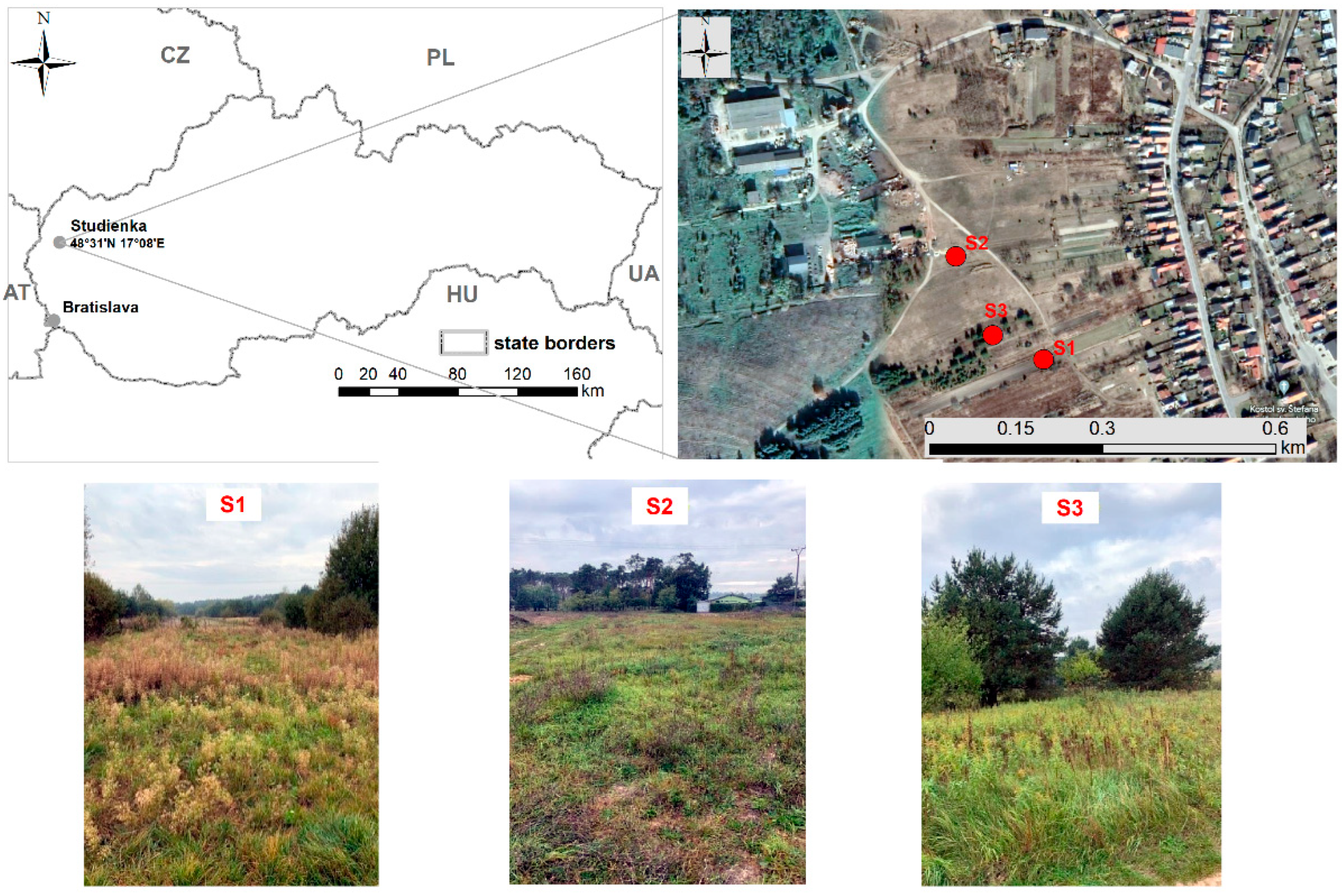
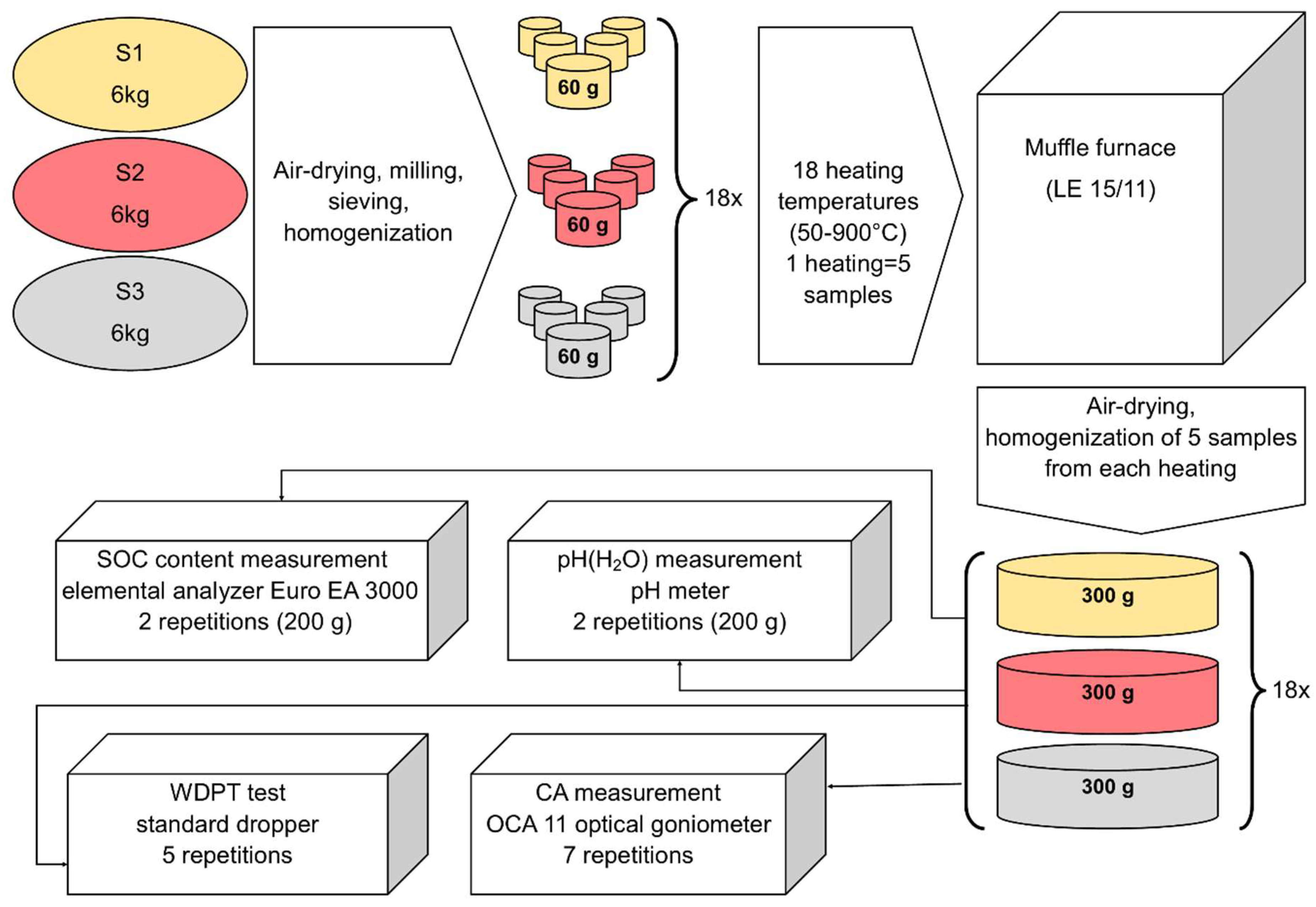
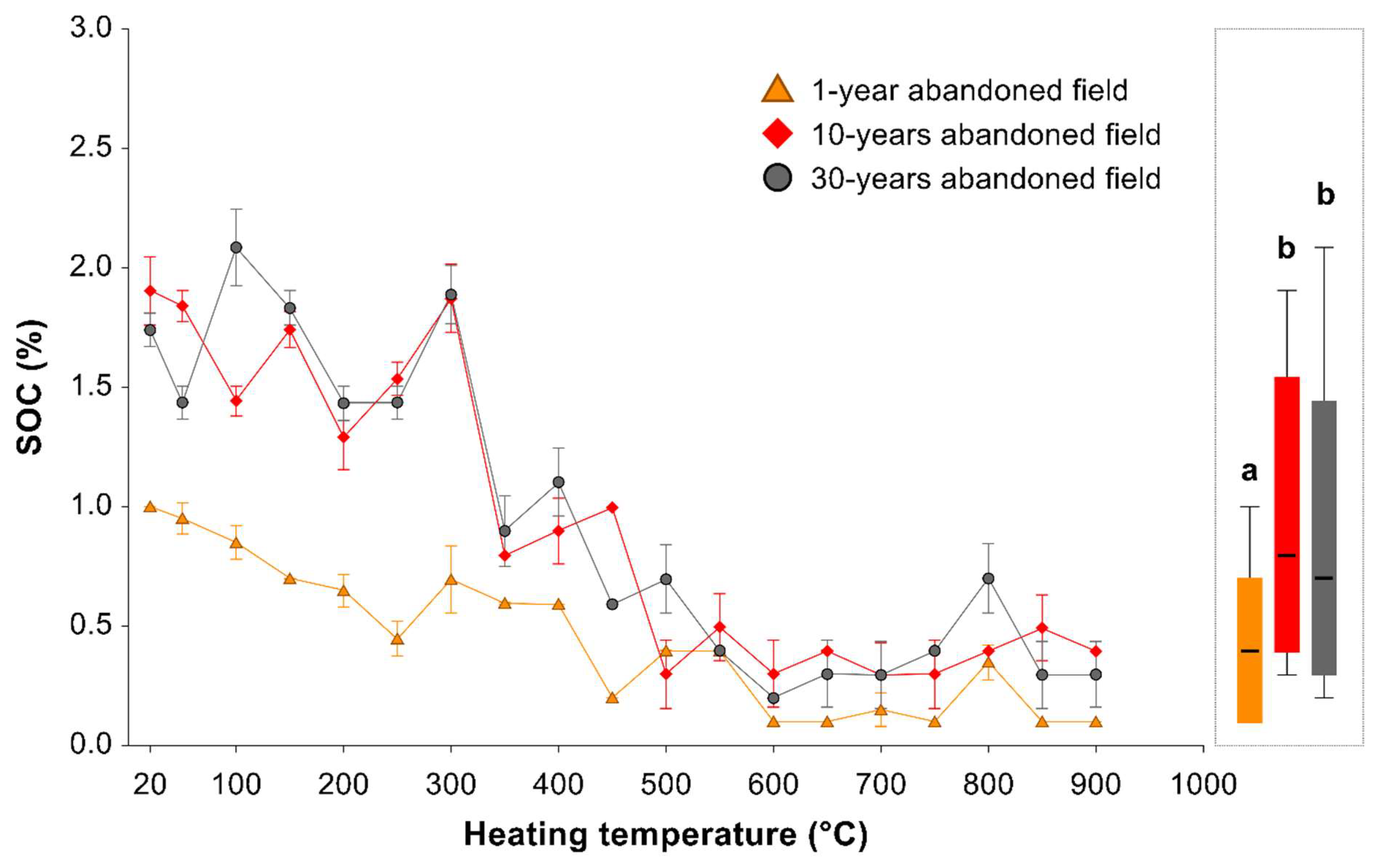

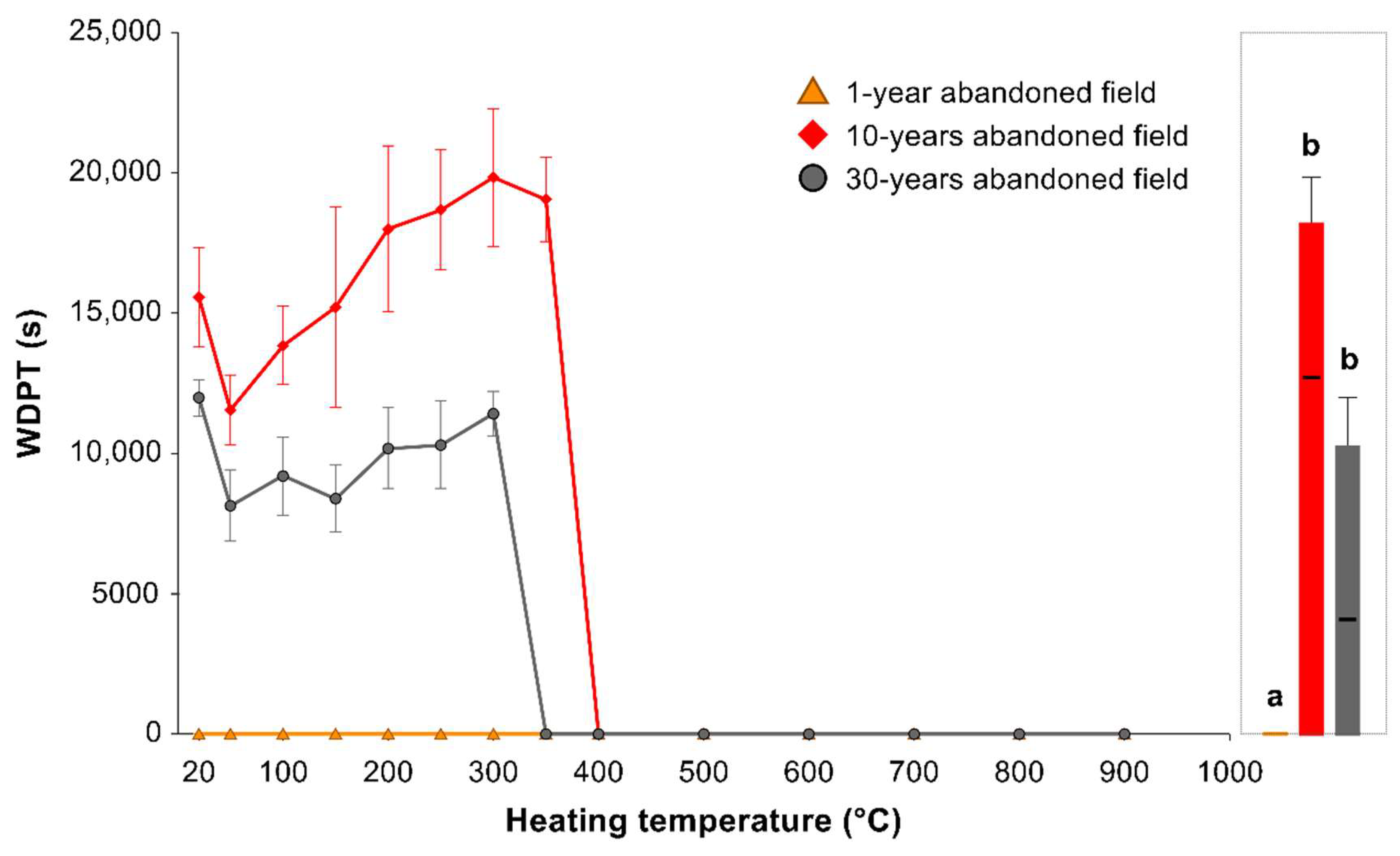
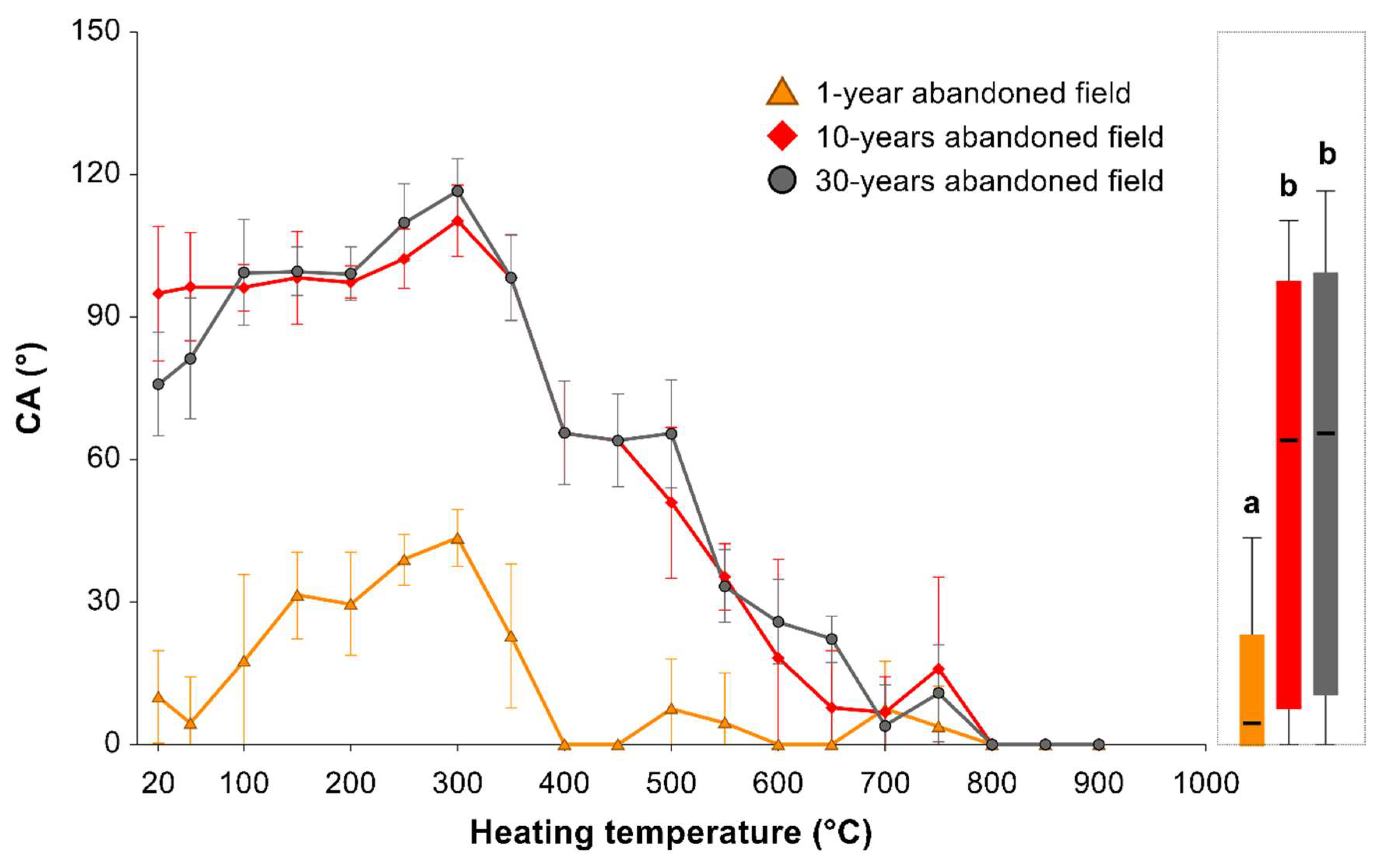
| Attribute | S1 | S2 | S3 |
|---|---|---|---|
| Sand (%) | 91.94 ± 0.54 | 95.38 ± 0.14 | 94.50 ± 0.03 |
| Silt (%) | 2.41 ± 0.43 | 1.57 ± 0.06 | 1.53 ± 0.05 |
| Clay (%) | 5.66 ± 0.12 | 3.06 ± 0.08 | 3.97 ± 0.02 |
| CaCO3 (%) | <0.05 | <0.05 | <0.05 |
| SOC (%) | 0.99 a ± 0.01 | 1.93 b ± 0.02 | 1.67 b ± 0.01 |
| pH | 6.25 a ± 0.01 | 6.78 a ± 0.01 | 6.19 a ± 0.01 |
Disclaimer/Publisher’s Note: The statements, opinions and data contained in all publications are solely those of the individual author(s) and contributor(s) and not of MDPI and/or the editor(s). MDPI and/or the editor(s) disclaim responsibility for any injury to people or property resulting from any ideas, methods, instructions or products referred to in the content. |
© 2023 by the authors. Licensee MDPI, Basel, Switzerland. This article is an open access article distributed under the terms and conditions of the Creative Commons Attribution (CC BY) license (https://creativecommons.org/licenses/by/4.0/).
Share and Cite
Šurda, P.; Lichner, Ľ.; Iovino, M.; Hološ, S.; Zvala, A. The Effect of Heating on Properties of Sandy Soils. Land 2023, 12, 1752. https://doi.org/10.3390/land12091752
Šurda P, Lichner Ľ, Iovino M, Hološ S, Zvala A. The Effect of Heating on Properties of Sandy Soils. Land. 2023; 12(9):1752. https://doi.org/10.3390/land12091752
Chicago/Turabian StyleŠurda, Peter, Ľubomír Lichner, Massimo Iovino, Slavomír Hološ, and Anton Zvala. 2023. "The Effect of Heating on Properties of Sandy Soils" Land 12, no. 9: 1752. https://doi.org/10.3390/land12091752
APA StyleŠurda, P., Lichner, Ľ., Iovino, M., Hološ, S., & Zvala, A. (2023). The Effect of Heating on Properties of Sandy Soils. Land, 12(9), 1752. https://doi.org/10.3390/land12091752









